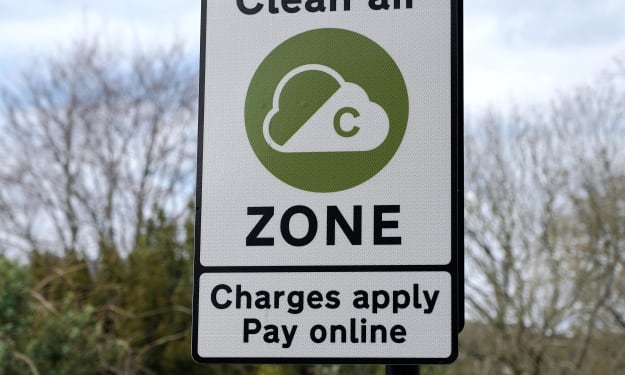WDYM ULEZ? cinch explains the latest car jargon
cinch, the faff-free way to buy a car online, has put together this handy jargon-busting guide. No more thinking ‘IDK’ when you see ABS, ESC or ACC.

Sometimes it feels like you need to be fluent in mechanic just to understand a car’s basic needs.
If you don’t know your ABS from your range anxiety or your E-REV from your dampers, you’re going to struggle.
Oh, and it turns out mayonnaise isn’t just a condiment you can have with chips, it’s also something that you find under the oil cap when coolant is mixing with the oil. Who knew?
There's so much jargon to get our heads around, it’s completely understandable if the topic drives you around the bend sometimes.
Most recently, we've added CAZ (Clean Air Zones) to the increasing list of motoring acronyms.
But what other new terminology is out there that we should know but probably don’t?
cinch, the faff-free way to buy a car online, has put together this handy jargon-busting guide. No more thinking ‘IDK’ when you see ABS, ESC or ACC.
Electric vehicles
Everyone’s talking about electric vehicles right now; in fact, it’s expected that 6.4 million of them will be on British roads by 2030, up from 1.2 million in 2023.
If you’re in the market for one or perhaps you just want to plug yourself into all the chatter, here are some of the most common terms you’ll see or hear about.
EV (Electric vehicle) – Quite simply, EV stands for electric vehicle. These electric cars run purely on electricity.
PHEV (Plug-in hybrid electric vehicle) – This type of vehicle uses batteries to power an electric motor as well as another type of fuel, such as petrol.
Range anxiety – If people are worried their vehicle will run out of charge or that they won’t be able to recharge when necessary, it’s called having range anxiety.
ICE (Internal combustion engine) – An ICE vehicle is powered by conventional resources such as petrol or diesel fuel.
BEV (Battery electric vehicle) – Unlike a hybrid vehicle, a BEV has no fuel tank at all and is therefore powered entirely by rechargeable batteries.
Charging speed: slow – Slow charging is generally anything between 2.3kW (kilowatts) and 3kW.
Charging speed: fast – This generally refers to charges delivered at 7-25kW.
Charging speed: rapid – Rapid charging is generally delivered at rates of 43kW and above.
Charging speed: ultra-rapid – This term refers to charging that generally takes place at anything up to 350kW
E-REV (Range-extended electric vehicles) – This type of vehicle runs on electricity only, but with an onboard generator to recharge the battery when it’s flat (unlike pure electric vehicles).
Laura Bailey, linguistics expert at Kent University, said: “When we create new technologies, we typically create their names in one of a few ways.
“We repurpose old words for newer things if they’re equivalent enough; we still use the word ‘film’ for the movies we stream, even though they’re not on film anymore.
“Similar words for cars might be ‘carriage’ or indeed ‘car’ itself, which originally meant something like a cart. Or we might invent brand new words for brand new things, often by using Latin or Greek word-parts.
“For the same reason that we still use ‘film’, I suspect people will continue to say ‘put your foot on the gas’ even with electric vehicles.
“The phrases we use might develop and shift their meanings towards electric vehicle usage, or we might gain new ones as electric vehicles become more common – or perhaps another technology will overtake and become the norm instead, with its own vocabulary.”
Clean air
In the UK, it’s estimated that road transport contributes 20-30% of national emissions of air pollutants.
Climate change has been a huge driving force behind many of the latest vehicle updates and driving regulations, and with these updates come more motoring terms we must get to grips with.
ULEZ (Ultra Low Emission Zone) – An area in London where a fee is charged for driving the most polluting vehicles, including many diesel cars registered before September 2015.
CC (Congestion Charge) – In London, if you drive your vehicle within the CC zone at a certain time, you’ll be charged a fee of £15. This is an attempt to minimise heavy city traffic while also reducing noise and air pollution.
Carbon-neutral – A term that refers to making or resulting in ‘no net release’ of carbon dioxide into the atmosphere. Electric cars are carbon neutral, while manufacturers themselves are taking steps to be carbon neutral in their processes by offsetting their emissions.
CAZ (Clean Air Zone) – You’ll likely spot the term CAZ being used to describe an area where action is being taken to improve air quality.
A CAZ (Class A Clean Air Zone) – Buses, coaches, taxis and private hire vehicles will be charged for driving in this zone.
B CAZ (Class B Clean Air Zone) – Those mentioned in A as well as heavy goods vehicles will be charged for driving in this zone.
C CAZ (Class C Clean Air Zone) – Those mentioned in B as well as vans and minibuses will be charged for driving in this zone.
D CAZ (Class D Clean Air Zone) – Those mentioned in C as well as cars will be charged for driving in this zone. The local authority also has the option to include motorcycles.
Technology and mechanics
The humble motor car has come a long way since its first iteration in the autumn of 1885.
Now, there are so many exciting features and an abundance of new technology. While those are both exciting and useful, it does mean more jargon and letters to understand.
ABS (Anti-lock braking system) – In the event of an emergency brake, this automatic system will prevent the wheels from locking.
ACC (Adaptive cruise control) – ACC can take control of your vehicle’s speed management – the system can even identify traffic ahead and adapt the car’s speed accordingly.
ESC (Electronic stability control) – When a loss of steering control is detected, the ESC program applies the brakes to that specific wheel.
Power steering – Any form of steering that’s assisted by hydraulic or electrical motors.
Dampers – These hydraulic suspension components prevent a car's springs from bouncing uncontrollably over potholes and bumps.
No more “IDK what that means”
How many terms from this list did you already know?
The world of motoring is constantly changing, and while it is important that we, as drivers, adapt, nobody can blame you for feeling a little confused from time to time.
Keep calm and remember, FAIL = First Attempt in Learning. You’ve got this!





Comments
There are no comments for this story
Be the first to respond and start the conversation.